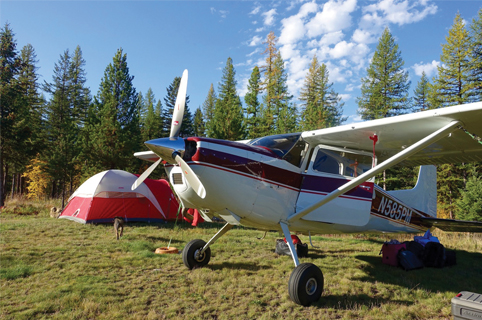
There’s nothing like the thrill and freedom of backcountry flying. This type of flying provides opportunities to explore beautiful, serene destinations that are inaccessible to anything other than a general aviation airplane or seaplane.
Backcountry airstrips and wilderness areas are incredibly special places, so it’s all the more important for recreational pilots to protect and preserve them for the enjoyment of future pilots. Take a look at these basic etiquette guidelines to follow when operating in the backcountry, and be sure to check out the Recreational Aviation Foundation’s complete Code of Conduct for even more recommendations and best practices for recreational aviators.
Know before you go
Before flying to an unfamiliar airstrip, do your homework. Learn about the airfield layout and runway direction. What’s the terrain like nearby? Are there high traffic areas for vehicles, visitors, wildlife, or other airplanes? Are there prominent landmarks or obstacles? Research the area thoroughly and talk to pilots who have visited before as you plan your flight. The RAF has created an online airfield guide to share safety briefings and detailed information about out-of-the-way airports and places most pilots don’t know about.
Embrace safety culture
As the pilot in command, safety is your responsibility. While backcountry flying may not require a special rating or sign-off from the FAA, it does come with its share of risks and challenges. Successfully flying in the backcountry requires a range of skills that you might not practice every day, particularly short field takeoffs and landings. Know your personal minimums and adhere to them. Always practice sound risk management and educate your passengers about emergency procedures.
Stay prepared for anything
With challenging terrain and weather, backcountry flying can be unpredictable. It’s essential to equip your aircraft with proper survival tools and supplies in case of an accident or forced landing. Make sure you have water, food, clothing, shelter, fire-making supplies, and a first aid kit on board. Carry redundant transceivers and navigational equipment. Consider taking a survival training course to help you prepare for post-crash conditions.
Be a courteous neighbor
Always act with respect and courtesy to those in the area you’re visiting, including wildlife. Don’t approach animals and never try to feed them. Try your best to minimize the environmental impact of your preflight and flight operations. For example, limit the discharge of fuel and oil during refueling. Reduce your noise signature by avoiding unnecessary takeoffs and landings. Be considerate of potential prop wash near sensitive wilderness areas and campsites. Avoid departing very early in the morning unless the safety of your flight requires a deviation.
Leave no trace
To keep backcountry airstrips and natural spaces safe and enjoyable for others, avoid leaving behind any trace of your visit. Perhaps the best way to protect the great outdoors is to adhere to the “pack it in, pack it out” practice. Before leaving, carefully inspect your campsite and rest areas for trash, leftover food, and litter. Dispose of waste properly and always try to leave an area better than you found it.
If you’re new to backcountry flying, don’t hesitate to reach out to experienced backcountry pilots for advice and recommendations. The backcountry community is known for being friendly and welcoming!
One valuable resource to turn to is The Recreational Aviation Foundation (RAF). Based in Montana, the organization is committed to preserving, protecting, maintaining, and creating backcountry airstrips for recreational access. Their website provides a wealth of helpful education and safety information for recreational aviators.
We love to hear about your backcountry flying adventures. Share your photos and stories with us on Facebook, Instagram, or Twitter.